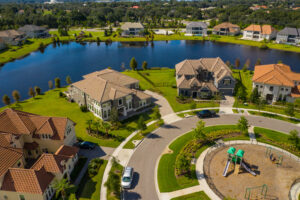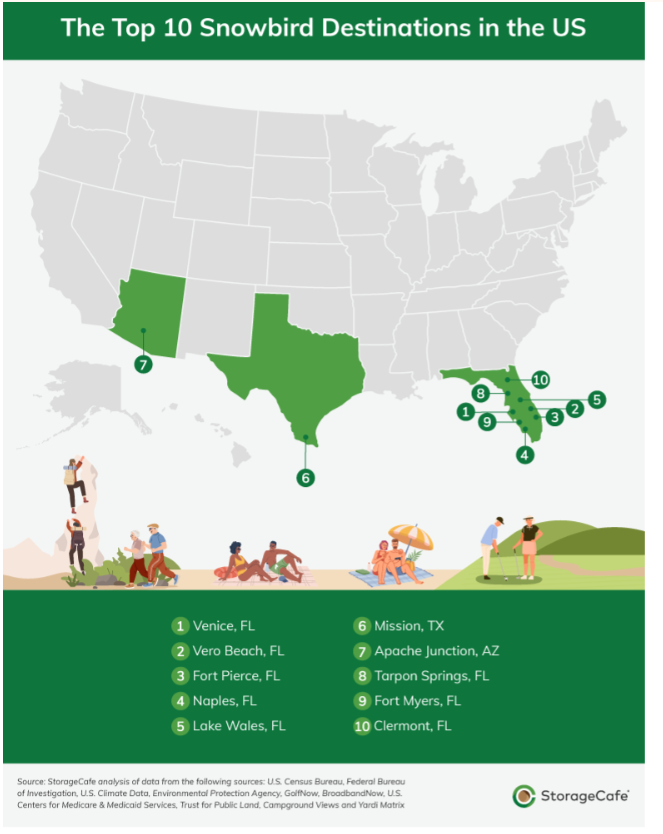 A new report from StorageCafe takes a closer look at the nation’s top destinations for snowbirds and the growing population of zoombirds who can now take remote work on the road to warmer climates during the winter months.
A new report from StorageCafe takes a closer look at the nation’s top destinations for snowbirds and the growing population of zoombirds who can now take remote work on the road to warmer climates during the winter months.
As the work-from-home trend has continued to grow in the aftermath of the pandemic, having tripled from 5.6% (8.7 million people) in 2019 to 17.8% (over 27 million people) in 2021, according to data from the U.S. Census Bureau. In 2022, 15% of Americans worked remotely, meaning that more than 24 million people were able to be flexible about their homebase.
For the study, StorageCafe determined which cities offered the best bang for the buck for snowbirds and zoombirds alike, while also taking into account the affordability aspect. Overall, 215 U.S. cities across 11 snowbird-friendly states were examined in terms of:
- Snowbird-friendly surroundings (October to March average temperatures, rainfall, and air quality)
- Beaches found within a 10-miles radius of each location
- Park space per capita
- Golf courses per capita
- Availability of both rentals and housing allocated for seasonal use
- The cost of renting an apartment and the cost of buying a home
- Availability of RV parks
- Number of restaurants
- Self-storage prices
- Local internet speed
- Safety
- Healthcare-related factors (Medicare pricing for new patients, and availability of hospitals, other medical organizations, and medical professionals)
When it came to overall friendliness for those seeking mild winters, Florida continued its popularity among snowbirds and zoombirds alike, reigning supreme on the list of top 100 cities for snowbirds, boasting an 42 total cities that make the top 100. Texas was a close second, securing 27 cities on the list, followed by California coming in third with 18 cities on the list.

Taking the top spot was Venice, Florida, boasting balmy weather throughout the entire winter season, but it also exceled in several other categories, including the share of housing units for seasonal use (87%), golf courses (ranking fifth best among the cities analyzed for golfers), as well as its health sector. There are nearly 36 doctors and clinicians and four medical organizations for every 1,000 residents.
Taking second place in the top 100, Vero Beach, Florida features nearly two-thirds of its vacant local housing stock as homes destined for seasonal use, and many of the other housing options in Vero Beach more budget-friendly than comparable locales across the nation. Golf culture is also particularly strong in Vero Beach, with the city ranking second among all the cities analyzed for access to golf courses.
Fort Pierce, Florida ranked number three in the top 100, featuring 1,000-square feet in park space per capita. Fort Pierce also ranked highly in the affordability department, with the median rent 30% less expensive than the state's median, while median home prices, at $147,000, are lower compared to any of the other Floridian cities in our top 10.
Coming in fourth was Naples, Florida, with the small Floridian city featuring the highest share of vacant housing units marked for seasonal use (89%) among all those analyzed, and it also ranked first for golf courses, dubbed the Golf Capital of the World. The median rent in Naples was 6% higher compared to the state's median rent, while the median house price is north of $1 million.
Rounding out the top five, yet another Sunshine State entry, Lake Wales, Florida, was one of two Floridian cities in our top 10 that does not come with a beach lifestyle–however, it does have access to the very lake it was named for, so there are still opportunities for fishing, bathing, and water sports.
Rounding out the top 10 destinations for snowbirds were:
- Mission, Texas
- Apache Junction, Arizona
- Tarpon Springs, Florida
- Fort Myers, Florida
- Clermont, Florida
For the study, StorageCafe analyzed all the U.S. cities with populations greater than 10,000, and analyzed 215 of them to determined the top 10 and top 100 best snowbird destinations. The metrics included in the overall score and their weightings are the following: October-March average temperature (15%); vacant housing units for seasonal, recreational, occasional, or renting use(15%); precipitations (5%); air quality (5%); offenses known to law enforcement as a percentage of population (13%); total beach length within a 10-mile radius of the city (5%); park surface per capita in the city (5%); number of RV parks in each city (2.5%); number of golf courses per 10K residents (2.5%); restaurants per 1,000 residents (2.5%); average internet speed (2.5%); median rent (7.5%), median house price (7.5%); average self-storage rate for a 10'×10' non-climate-controlled unit (2.5%); Medicare pricing for new patients (2.5%), hospitals per 10K residents (2.5%), doctors and clinicians per 1,000 residents (2.5%), and medical organizations per 1,000 residents (2.5%).
Click here for more information on StorageCafe’s analysis of top U.S. destinations for snowbirds and zoombirds.

 theMReport.com Your trusted source for mortgage banking news
theMReport.com Your trusted source for mortgage banking news








